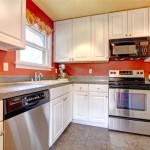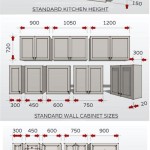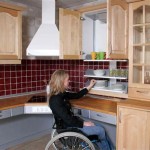Two-Tone Grey Kitchen Cabinets: A Comprehensive Guide
The kitchen, often considered the heart of the home, undergoes constant design evolution. Among the myriad of trends shaping kitchen aesthetics, the use of two-tone cabinetry, particularly featuring shades of grey, has gained significant traction. This approach allows for visual interest, depth, and a personalized touch, transforming a functional space into a design statement. Two-tone grey kitchen cabinets offer a versatile platform, adaptable to various architectural styles and personal preferences.
The allure of grey lies in its neutrality. Acting as a sophisticated backdrop, it complements a vast array of colors and materials. When incorporated into a two-tone scheme, grey provides a grounding element, balancing bolder hues or highlighting subtle textures. This article explores the various facets of two-tone grey kitchen cabinets, encompassing design considerations, color pairings, material selections, hardware choices, and lighting strategies, providing a comprehensive guide for homeowners and design professionals alike.
Understanding the Concept of Two-Tone Cabinetry
Two-tone cabinetry, in its simplest form, refers to the strategic use of two different colors on kitchen cabinets. This can involve differentiating between upper and lower cabinets, highlighting an island, or emphasizing specific sections like a pantry or appliance hutch. The primary goal is to create visual contrast and break the monotony of a single color scheme. This technique can make a kitchen feel larger, more interesting, and more personalized.
The successful implementation of a two-tone scheme relies on careful consideration of the kitchen's layout, size, and existing architectural features. A well-executed design will enhance the room's overall aesthetic appeal, whereas a poorly planned scheme can lead to a disjointed and unbalanced look. Therefore, meticulous planning and attention to detail is crucial.
The differentiation is not solely based on color. Material variations can also contribute to the two-tone effect. For instance, pairing painted cabinets with wood veneer cabinets, or laminates with solid surfaces, can create a textured and visually appealing design. The key is to ensure that the chosen materials complement each other in terms of color, texture, and overall style.
Exploring Grey Color Variations and Complementary Hues
The grey color family is remarkably diverse, encompassing a spectrum of shades from cool, almost blue-toned greys to warm, greige hues with hints of beige. Selecting the right grey tone is paramount to achieving the desired aesthetic. Cool greys often convey a modern, minimalist feel, while warmer greys lend themselves to more traditional or transitional designs.
When pairing grey with a second color, the options are plentiful. White, a classic choice, creates a clean and crisp contrast, suitable for both modern and traditional kitchens. Navy blue, another popular selection, adds a sophisticated and nautical touch, particularly effective when used on lower cabinets. Green, in its various shades from olive to emerald, introduces a natural and organic element, complementing the neutrality of grey.
For those seeking a bolder statement, consider incorporating brighter accent colors like yellow, orange, or red. These vibrant hues can be introduced through smaller design elements, such as backsplashes, accessories, or even interior cabinet lighting. The key is to use these colors sparingly to avoid overwhelming the space. Metallics, such as gold, brass, and copper, can also be paired with grey to add a touch of luxury and sophistication.
Consider the undertones of both grey and the secondary color. A grey with cool undertones will pair best with cool-toned colors, while a warm grey will harmonize with warm-toned colors. Mixing cool and warm tones can be challenging, but when executed correctly, it can create a dynamic and visually interesting space. Consulting with a color expert or using online color palette tools can be beneficial in navigating these nuanced decisions.
Material Selection and Finishes for Grey Cabinets
The material used for kitchen cabinets significantly impacts their durability, appearance, and overall cost. When opting for grey cabinets, the material choices are extensive, ranging from solid wood to engineered wood products like MDF and plywood.
Solid wood cabinets offer a premium look and feel, known for their durability and longevity. Hardwoods like maple, oak, and cherry are popular choices, each offering unique grain patterns and staining characteristics. However, solid wood cabinets are typically more expensive than other options.
MDF (Medium-Density Fiberboard) is a cost-effective alternative, providing a smooth and stable surface ideal for painting. MDF is less prone to warping or cracking than solid wood, making it a suitable choice for painted cabinets. Plywood, another engineered wood product, offers a balance of affordability and durability, often used for cabinet boxes and shelving.
The finish applied to the cabinets also plays a crucial role in their appearance and performance. Painted finishes, available in a wide range of sheens from matte to high-gloss, offer versatility in color and style. Lacquer finishes provide a durable and smooth surface, while thermofoil finishes offer a seamless and easy-to-clean option. Wood veneer finishes showcase the natural beauty of wood grain, often with a protective coating for added durability.
Consider the texture of the cabinet material. A textured finish, such as a raised panel or shiplap design, can add depth and visual interest to the two-tone scheme. Smooth, flat-panel cabinets offer a more modern and minimalist aesthetic.
Hardware Considerations for Two-Tone Grey Kitchen Cabinets
Cabinet hardware, including knobs, pulls, and hinges, serves both functional and decorative purposes. The right hardware can enhance the overall design of the kitchen, complementing the cabinet color and style. When selecting hardware for two-tone grey cabinets, consider the material, finish, and style of the hardware.
Metal hardware, such as stainless steel, brushed nickel, and brass, are popular choices for modern and contemporary kitchens. Stainless steel offers a clean and minimalist look, while brushed nickel provides a warmer and more muted appearance. Brass hardware adds a touch of elegance and sophistication, particularly when paired with darker grey cabinets.
For traditional kitchens, consider using hardware with more ornate detailing, such as antique brass or oil-rubbed bronze. These finishes often feature intricate designs and a vintage aesthetic. Ceramic knobs and pulls can also add a touch of charm to traditional kitchens.
The size and shape of the hardware should be proportionate to the size of the cabinet doors and drawers. Smaller knobs are suitable for smaller cabinets, while larger pulls are better suited for larger drawers. Consider the ergonomic aspects of the hardware, ensuring that it is comfortable to grip and use.
Coordinate the hardware finish with other metal elements in the kitchen, such as the faucet, lighting fixtures, and appliance finishes. This will create a cohesive and harmonious look throughout the space.
Lighting Strategies to Enhance Two-Tone Grey Cabinets
Lighting plays a critical role in highlighting the beauty and functionality of a kitchen. Strategic lighting can enhance the color and texture of the two-tone cabinets, creating a warm and inviting atmosphere. Consider a combination of ambient, task, and accent lighting to achieve optimal results.
Ambient lighting provides overall illumination for the kitchen, typically achieved through recessed lighting, pendant lights, or chandeliers. Task lighting focuses on specific work areas, such as the countertops and sink, often provided by under-cabinet lighting or pendant lights above the island.
Accent lighting highlights specific features of the kitchen, such as the backsplash, artwork, or decorative cabinets. This can be achieved through spotlights, track lighting, or interior cabinet lighting. LED strip lighting is a popular choice for under-cabinet lighting and interior cabinet lighting, providing energy-efficient and customizable illumination.
Consider the color temperature of the light bulbs. Warm white light (2700-3000K) creates a cozy and inviting atmosphere, while cool white light (3500-4100K) provides a brighter and more functional illumination. Adjust the color temperature to complement the color of the cabinets and the overall style of the kitchen.
Dimmers allow for adjusting the brightness of the lights, providing greater control over the ambiance of the kitchen. This is particularly useful for creating a relaxing atmosphere during meals or entertaining.
Under-cabinet lighting is particularly effective in highlighting the countertop area and the lower cabinets in a two-tone scheme. It enhances visibility and adds a touch of sophistication to the kitchen. Interior cabinet lighting can illuminate the contents of the cabinets, making it easier to find items and adding a touch of luxury.
Countertop and Backsplash Pairings with Grey Cabinets
Countertops and backsplashes are crucial elements in the overall kitchen design. The right countertop and backsplash materials can complement the grey cabinets and enhance the overall aesthetic appeal. When selecting these elements, consider the color, texture, and durability of the materials.
Quartz countertops are a popular choice for modern kitchens, offering durability, low maintenance, and a wide range of colors and patterns. White quartz countertops create a clean and crisp contrast with grey cabinets, while grey quartz countertops offer a more subtle and cohesive look. Marble countertops add a touch of luxury and elegance, but require more maintenance than quartz.
Granite countertops offer a natural and unique look, each slab featuring distinct veining and patterns. Dark granite countertops create a dramatic contrast with lighter grey cabinets, while lighter granite countertops offer a more subtle and understated look. Butcher block countertops add warmth and texture to the kitchen, complementing the neutrality of grey cabinets.
For backsplashes, consider using ceramic tile, glass tile, or natural stone. White subway tile is a classic choice that complements grey cabinets in both modern and traditional kitchens. Glass tile offers a sleek and contemporary look, available in a wide range of colors and finishes. Natural stone backsplashes, such as marble or travertine, add texture and sophistication to the kitchen.
Consider the size and shape of the backsplash tiles. Larger tiles create a more modern and seamless look, while smaller tiles offer a more traditional and detailed appearance. Experiment with different patterns and layouts, such as herringbone or stacked patterns, to add visual interest to the backsplash. Incorporate accent tiles or decorative elements to personalize the backsplash and complement the overall kitchen design.
Flooring Options for Kitchens with Two-Tone Grey Cabinets
The flooring in a kitchen should be both aesthetically pleasing and practical, able to withstand heavy foot traffic and potential spills. When paired with two-tone grey cabinets, the flooring choice contributes significantly to the overall ambiance and style of the space. Several options are available, each offering unique advantages in terms of cost, durability, and design versatility.
Hardwood flooring brings warmth and natural beauty to a kitchen. Light-toned hardwoods, such as maple or birch, can create a bright and airy feel, complementing lighter shades of grey in the cabinetry. Darker hardwoods, like walnut or oak, can provide a striking contrast, particularly when paired with lighter grey cabinets. However, hardwood requires careful maintenance to prevent damage from moisture and spills.
Tile flooring is a durable and water-resistant option, making it well-suited for kitchens. Ceramic and porcelain tiles come in a wide array of colors, patterns, and sizes, offering extensive design flexibility. Neutral-toned tiles, such as grey, beige, or white, can create a cohesive and timeless look. Patterned tiles can add visual interest and personality to the space, particularly when used in conjunction with simpler cabinet designs.
Luxury vinyl plank (LVP) flooring has emerged as a popular choice due to its durability, affordability, and realistic wood or tile appearance. LVP is water-resistant, easy to clean, and comfortable underfoot, making it a practical option for busy kitchens. It is available in a wide range of styles, mimicking the look of hardwood, tile, or stone.
Consider the overall style of the kitchen and the color palette when selecting flooring. A modern kitchen might benefit from sleek and minimalist tile or LVP, while a traditional kitchen could be enhanced by warm-toned hardwood or patterned tile. The flooring should complement the cabinets and other design elements, creating a harmonious and inviting space.
Appliance Integration in Two-Tone Grey Kitchen Designs
Appliances are integral to the functionality and aesthetics of a kitchen. Integrating appliances seamlessly into the two-tone grey cabinet design enhances the overall visual appeal and creates a cohesive look. Choosing the right appliance finishes and placement is crucial for achieving a balanced and harmonious design.
Stainless steel appliances are a classic choice that complements grey cabinets in both modern and traditional kitchens. Stainless steel provides a clean and contemporary look, blending well with a variety of colors and textures. However, stainless steel can show fingerprints and smudges, requiring regular cleaning.
Black appliances offer a bold and dramatic contrast with lighter grey cabinets, creating a sophisticated and contemporary look. Black appliances can also help to ground the space and add visual interest. White appliances provide a clean and minimalist look, blending seamlessly with light-colored cabinets. White appliances are particularly well-suited for smaller kitchens, helping to create a brighter and more open feel.
Panel-ready appliances allow you to integrate appliances seamlessly into the cabinetry, creating a custom and cohesive look. Panel-ready appliances can be covered with cabinet panels that match the surrounding cabinets, making them virtually invisible. Integrated appliances are a popular choice for high-end kitchens, offering a sleek and seamless design.
Consider the placement of appliances within the kitchen layout. Grouping appliances together, such as the refrigerator, oven, and microwave, can create a more efficient and functional workspace. Strategically placing appliances to balance the visual weight of the kitchen and avoid creating overly dominant or unbalanced areas is essential.

12 Stunning Two Toned Kitchens Cococozy Kitchen Cabinets Decor Cabinet Design Modern

Two Toned Grey And White Kitchen Renovation Home Bunch Interior Design Ideas

A Coastal Kitchen Renovation With Two Toned Cabinets Blogger Helen Of Style Inherited Mindybriar Com

100 Two Tone Kitchens Ideas In 2024 Kitchen Fittings Inspirations

91 Timeless Grey And White Kitchen Designs Digsdigs

Modern Grey Kitchen Cabinets We Re Loving Now Semistories
:strip_icc()/cdn.cliqueinc.com__cache__posts__250323__two-toned-kitchen-cabinets-250323-1519325262269-image.700x0c-54b3bbdb21c94f9588e9188af902bb2e-861f3fa941a94a40adb5cdea7936947d.jpg?strip=all)
30 Stylish Two Toned Kitchen Ideas From An Expert

High Gloss Two Tone Kitchen Bedford Nh Norfolk Bath

A Coastal Kitchen Renovation With Two Toned Cabinets Blogger Helen Of Style Inherited Mindybriar Com

20 Grey Kitchen Designs Showing Off Modern Cabinets
Related Posts








